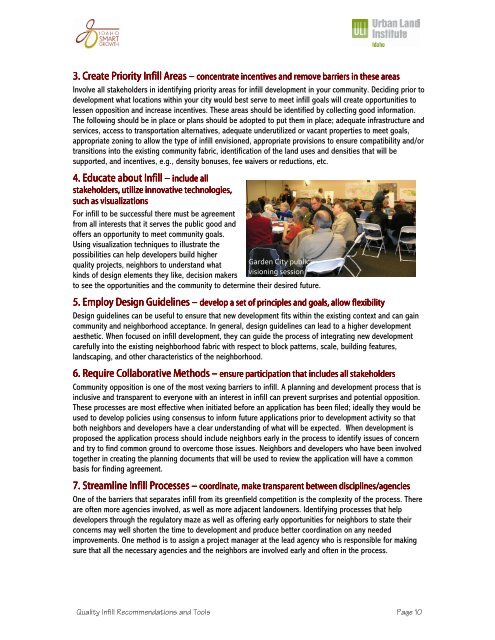Quality Infill Quality Infill - Idaho Smart Growth
Quality Infill Quality Infill - Idaho Smart Growth
Quality Infill Quality Infill - Idaho Smart Growth
Create successful ePaper yourself
Turn your PDF publications into a flip-book with our unique Google optimized e-Paper software.
3. 3. Create Create Create Priority Priority <strong>Infill</strong> <strong>Infill</strong> Areas Areas – concentrate concentrate incentives incentives and<br />
and<br />
concentrate incentives and remove remove barriers barriers in in these these these areas<br />
areas<br />
Involve all stakeholders in identifying priority areas for infill development in your community. Deciding prior to<br />
development what locations within your city would best serve to meet infill goals will create opportunities to<br />
lessen opposition and increase incentives. These areas should be identified by collecting good information.<br />
The following should be in place or plans should be adopted to put them in place; adequate infrastructure and<br />
services, access to transportation alternatives, adequate underutilized or vacant properties to meet goals,<br />
appropriate zoning to allow the type of infill envisioned, appropriate provisions to ensure compatibility and/or<br />
transitions into the existing community fabric, identification of the land uses and densities that will be<br />
supported, and incentives, e.g., density bonuses, fee waivers or reductions, etc.<br />
4. 4. Educate Educate about about <strong>Infill</strong> <strong>Infill</strong> – include include all<br />
all<br />
stakeholders, stakeholders, utilize utilize innovative innovative technologies,<br />
technologies,<br />
such such as as visualizations<br />
For infill to be successful there must be agreement<br />
from all interests that it serves the public good and<br />
offers an opportunity to meet community goals.<br />
Using visualization techniques to illustrate the<br />
possibilities can help developers build higher<br />
quality projects, neighbors to understand what Garden City public<br />
kinds of design elements they like, decision makers<br />
visioning session<br />
to see the opportunities and the community to determine their desired future.<br />
5. 5. Employ Employ Design Design Guidelines Guidelines – develop a set of principles and goals, goals, allow flexibil<br />
develop a set of principles and goals, allow flexibility ity ity<br />
Design guidelines can be useful to ensure that new development fits within the existing context and can gain<br />
community and neighborhood acceptance. In general, design guidelines can lead to a higher development<br />
aesthetic. When focused on infill development, they can guide the process of integrating new development<br />
carefully into the existing neighborhood fabric with respect to block patterns, scale, building features,<br />
landscaping, and other characteristics of the neighborhood.<br />
6. 6. Require Require Collaborative Collaborative Methods Methods – ensure ensure participation participation that that incl<br />
incl<br />
ensure participation that includes udes all stakeholders<br />
Community opposition is one of the most vexing barriers to infill. A planning and development process that is<br />
inclusive and transparent to everyone with an interest in infill can prevent surprises and potential opposition.<br />
These processes are most effective when initiated before an application has been filed; ideally they would be<br />
used to develop policies using consensus to inform future applications prior to development activity so that<br />
both neighbors and developers have a clear understanding of what will be expected. When development is<br />
proposed the application process should include neighbors early in the process to identify issues of concern<br />
and try to find common ground to overcome those issues. Neighbors and developers who have been involved<br />
together in creating the planning documents that will be used to review the application will have a common<br />
basis for finding agreement.<br />
7. 7. Streamline Streamline <strong>Infill</strong> <strong>Infill</strong> Processes Processes – coordinate<br />
coordinate<br />
coordinate, , make tra transparent tra<br />
nsparent nsparent between disciplines/<br />
disciplines/agencies<br />
disciplines/<br />
agencies<br />
One of the barriers that separates infill from its greenfield competition is the complexity of the process. There<br />
are often more agencies involved, as well as more adjacent landowners. Identifying processes that help<br />
developers through the regulatory maze as well as offering early opportunities for neighbors to state their<br />
concerns may well shorten the time to development and produce better coordination on any needed<br />
improvements. One method is to assign a project manager at the lead agency who is responsible for making<br />
sure that all the necessary agencies and the neighbors are involved early and often in the process.<br />
<strong>Quality</strong> <strong>Infill</strong> Recommendations and Tools Page 10


